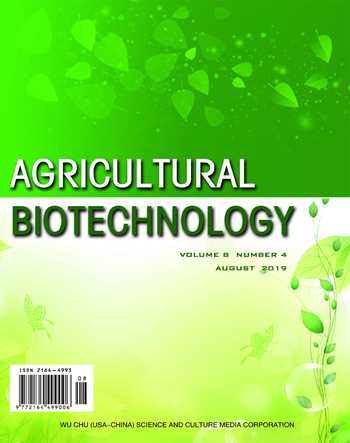Exploratory Application of X-ray Photography in the Diagnosis of Poultry Fatty Liver
Yiqi ZHANG Jiao LI Jintang LUO Dongxu WANG Yuanqing ZHONG Yihao ZHANG Suohua ZHAO


Abstract [Objectives] This study was conducted to explore the application value of X ray in the diagnosis of poultry fatty liver.
[Methods] Serum biochemical tests were performed on laying hens with suspected fatty liver. The Xray liver images of the left lateral position were observed. And the liver traits were observed by anatomy.
[Results] The increase in liver space occupying lesion observed by Xray photography was consistent with the increase in liver volume observed by anatomy.The biochemical test showed slight liver function abnormalities.
[Conclusions] Xray examination can be used for the auxiliary diagnosis of poultry fatty liver.
Key words Poultry; Fatty liver; Xray; Auxiliary diagnosis
The health of laying hens plays an important role in the laying performance. Fatty liver is a common metabolic disease in the production of laying hens by intensive cage culture, which usually occurs in the chicken flocks at the peak of egg production in a condition of overnutrition[1-2], causing the decline in egg production performance and thus large economic losses to the farm. Therefore, it is very important for the early diagnosis and prevention of fatty liver. However, fatty liver is often found after the egg production rate is reduced and the dead chickens are dissected when it is too late to treat the disease. Consequently, it is of great clinical significance to have an early detection of the tendency of fatty liver in laying hens to prevent and control the development of fatty liver.
Materials and Methods
Test materials
The tested cases were 200dayold Xueshan chickens in the experimental farm of Tianjin Agricultural College. The diet of highyielding laying hens was implemented for nearly 3 months. The hens were normal in appetite and feces, but the eggs were small and the body weight was high, which was speculated to be caused by excessive fat deposition or fatty liver.
Test methods
General clinical examination
The color of the feather of the laying hens was good, as well as the color of the cockscomb and the meat. The laying hens were also normal in mental state, but had a high weight and a large abdomen, and the chest and abdomen were full when touched.
Biochemical tests
The biochemical tests included serum biochemical index examination, Xray examination, and anatomy of lesions.
Results and Analysis
Test results of serum biochemical indexes
After the hens were fasted for 12 h, the blood was collected from the wing veins and centrifuged at 3 000 r/min for 10 min, obtaining the serum, which was detected using an automatic biochemical analyzer. The results are shown in Table 1.
X ray examination
The hens were subjected to Xray examination at the upper left lateral position when fixed by hands. The results are shown in Fig. 1.
Xray results showed that the lateral and lower margins of the liver lobe occupied a larger area, suggesting that the liver increased.
Anatomy for lesions
After the blood collection and Xray photography, the hens were dissected, and the fat deposition in the abdominal cavity and internal organs, liver size, shape, color and development of ovary were observed. The results are shown in Fig. 2.
After dissection, it was found that a large amount of fat was deposited in the abdominal cavity and mesentery. The color of the liver was ruddy with thickened edge, exhibiting increased volume; and the ovary was normal.
Diagnosis results
It could be seen from the comprehensive anatomy that the volume of liver was increased as the margin was thickened and a large amount of fat was deposited in the abdominal cavity and mesentery, and the ovarian development was normal. The biochemical results showed that the globulin and total bilirubin showed a slight increase, while other indexes were normal. The diagnosis result was that the laying hens suffered from early fatty liver[3].
Conclusions and Discussion
The Xray results showed that the liver of the laying hens increased, indicating that there was a tendency of fatty liver, which was consistent with the liver increase and marginal thickening observed in the dissection. A large amount of fat was deposited in the abdominal cavity and mesentery, and abnormal liver function was observed. The dissection diagnosis and the biochemical test results were basically the same[4]. Therefore, X photography can be used for the initial diagnosis of poultry fatty liver, especially for the auxiliary diagnosis of some precious birds, eliminating the fatal diagnosis of slaughter and dissection, while the best position for poultry fatty liver examination by Xray photography still needs further study[5].
References
[1] LUO ZM, HAN LX, WANG AD. Diagnostic points and comprehensive prevention and control of fatty liver in caged hens[J]. China Animal Health, 2016, 18(9): 44-45. (in Chinese)
[2] GUO ZH. Causes, clinical symptoms and prevention measures of fatty liver syndrome in laying hens[J]. Technical Advisor for Animal Husbandry, 2016(10): 107. (in Chinese)
[3] XING YJ, ZHAO WD, ZHU H, et al. Establishment of a model of fatty liver syndrome in laying hens[J]. China Animal Husbandry and Veterinary Medicine, 2018, 45(5): 1401-1407. (in Chinese)
[4] XIE FQ. Veterinary Imaging[M]. Beijing: China Agricultural University Press, 2010. (in Chinese)
[5] YANG L, LIANG F. Investigation report on the setup passing rate of Xray photography[C]∥Proceedings of the 15thSymposium of the Veterinary Imaging Technology Branch of Chinese Association of Animal Science and Veterinary Medicine, 2016. (in Chinese)
Editor: Yingzhi GUANG Proofreader: Xinxiu ZHU
- 农业生物技术(英文版)的其它文章
- Advances in the Coenzyme Q10 Biosynthesis Pathway in Rhodobacter sphaeroides and the Enha
- Differences in Chlorophyll Fluorescence Parameters Yield and Its Components Between Different Genotypes of Wheat Under Waterlogging Conditions at Anthesis
- Breeding of a Natural Green Cocoon Quaternary Hybrid Combination Xiangcailu No.1 for Spring Reari
- Bioinformatics and Expression Analysis of CaERF Gene in Capsicum
- A Review on the Protection Mechanism of Trehalose on Plant Tissues and Animal Cells
- Genetic Diversity Analysis of Cherry Tomato Core Collection Based on Genotypic Values

